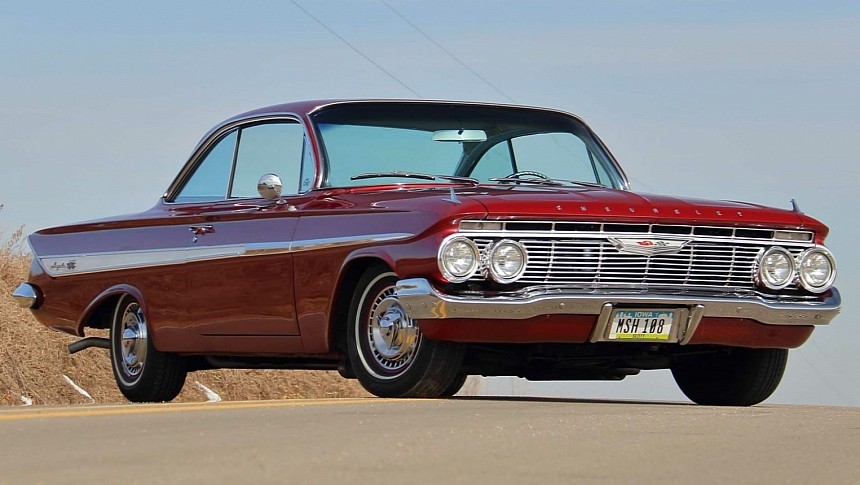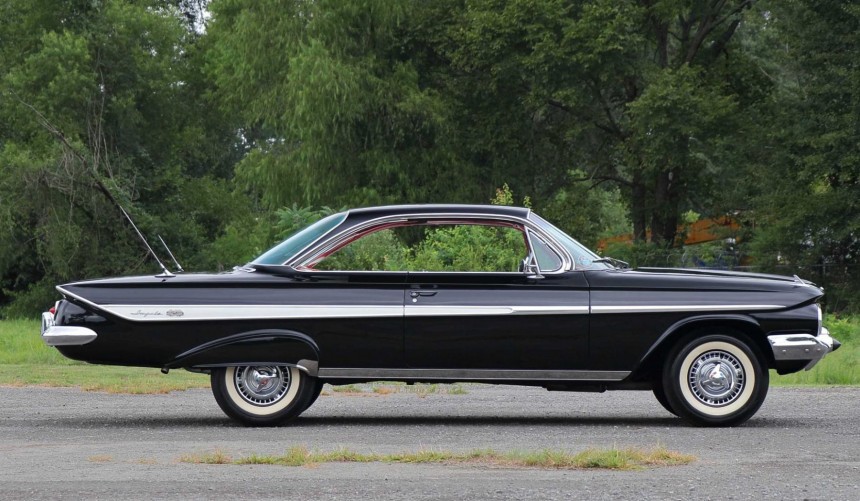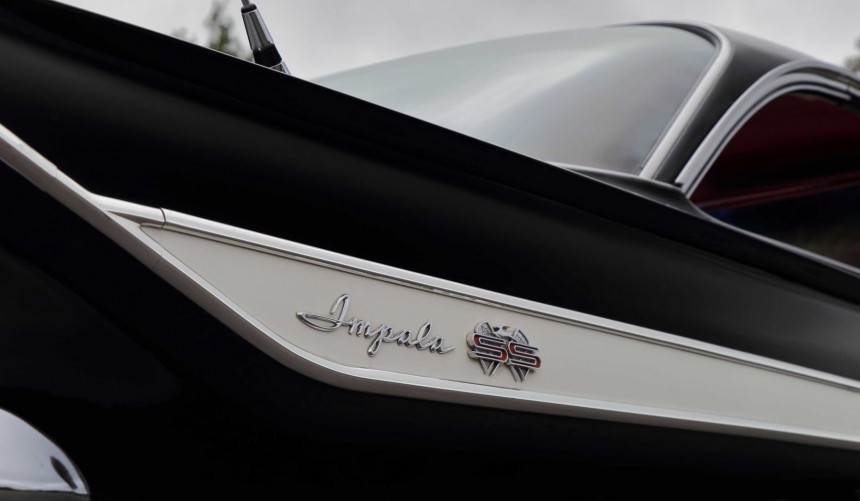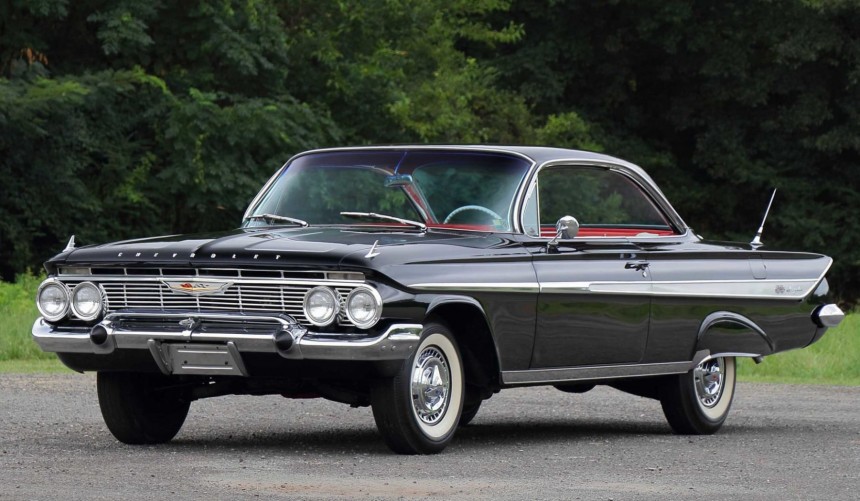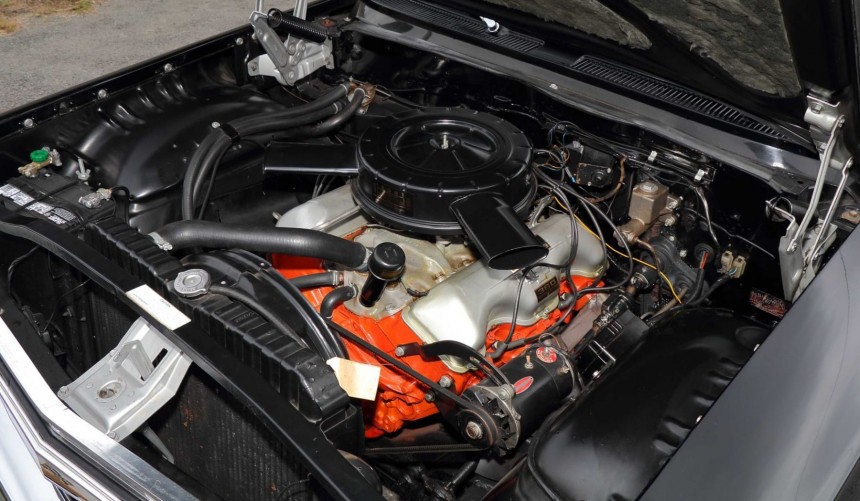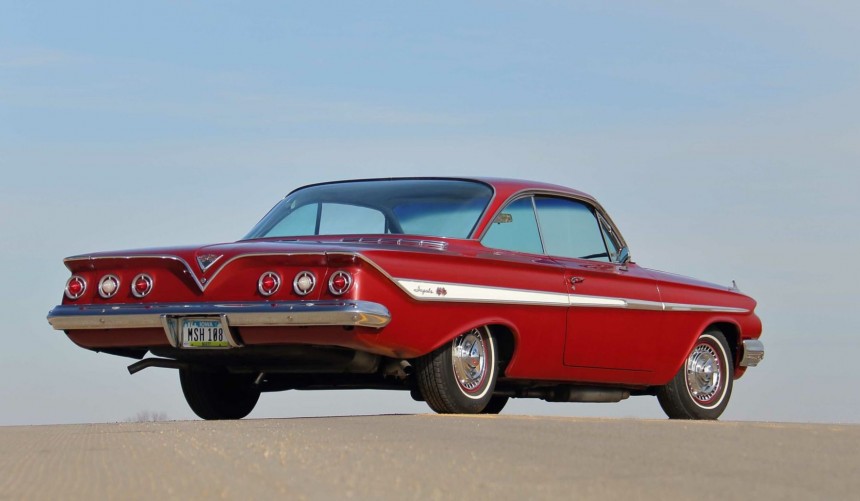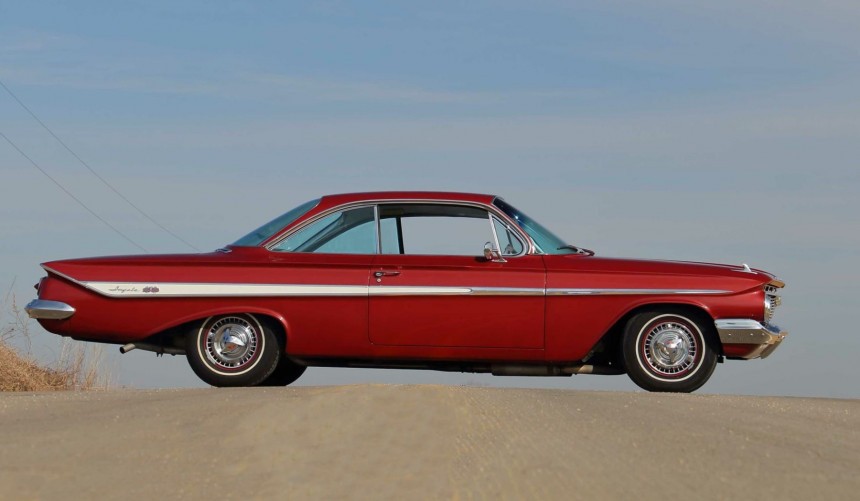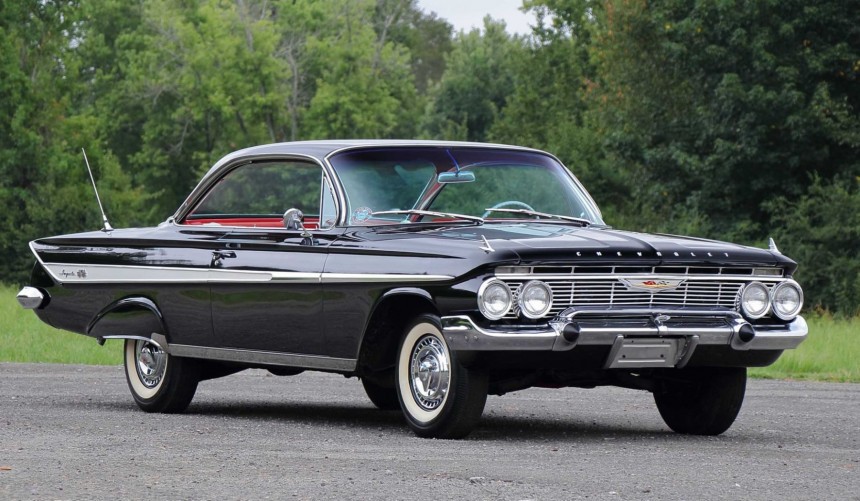Though its size disqualifies it from being an actual muscle car in the eyes of purists, the '61 Impala SS was the first 1960s model that offered a high-performance package on an affordable platform, which prompted other carmakers to follow suit.
It's generally accepted that Pontiac was responsible for starting the muscle car craze in 1964 when the GM division added the GTO package to the Tempest's option list.
A horsepower war ensued in the following years, which led to some of the most legendary vehicles ever produced by the American automotive industry.
But while Pontiac's GTO was an important milestone in the horsepower war that defined the muscle car era, another GM division fired the first shot three years earlier.
The Impala debuted in 1958 as the range-topping trim of Chevy's passenger car flagship, the Bel Air.
Only a year later, the Impala was redesigned and became a separate line. Built around the new X-frame and sharing many body panels with lower-end Pontiacs, Buicks, and Oldsmobiles, the full-size model was now more affordable, making it very popular among new car buyers.
The model's popularity prompted Chevy to give it another thorough redesign for the 1961 model year.
The new, third-generation Impala used GM's B-body platform that improved maneuverability and was now more in tune with the latest design trends, boasting a boxy yet aggressively elegant body.
Other notable changes were the addition of a two-door pillared sedan and the now-iconic "bubble top" roof on the two-door pillarless Sport Coupe sedan.
The 1961 Impala remained a conventional full-size model with little to offer in terms of factory performance. But that changed mid-model year when Chevy unceremoniously introduced an exciting new package.
With hot-rodding and drag racing becoming increasingly popular, especially among the younger demographic, the GM division decided that a sportier trim would help boost sales of the Impala even further.
Therefore, In December 1960, performance enthusiasts were given an early Christmas gift with the announcement of the Super Sport package.
Available in dealerships from February 1961 on any Impala body style for an extra $53.80 ($535.83 in 2023 money), the SS added chassis reinforcements, beefier springs, brakes with sintered metallic linings, new wheel covers, and narrow-band whitewall tires.
Inside, the only additions were a steering column-mounted tach and a Corvette-style grab handle on the passenger side of the dash.
That grab handle conceived for nervous passengers signaled that the SS was no basic Impala with sporty features but a performance model that could really go.
Unlike standard Impalas, which were available with lesser inline-sixes and V8s, the SS-equipped cars could only be had with Chevy's most potent big-bocks.
The standard SS engine was the 348-ci (5.7 liter) that could make 305 hp courtesy of a single four-barrel carb.
Next in line was another single four-barrel version rated at 340 hp thanks to a higher compretion ratio, while the range-topping 348 was equipped with a triple four-barrel carb that helped it produce 350 hp.
Although these engines were enough to quench the thirst for factory performance, Chevy didn't stop there, adding an even larger, more powerful V8 to the Impala SS option list.
While all three versions of the 348 could be fitted into the engine bay of any Impala, the all-new 409 was only available with the SS package starting .
Essentially an enlarged version of the 348, the 409 was developed to deliver a top-of-the-line performance engine.
Apart from the displacement increase, the V8 received a host of improvements, like forged aluminum pistons, a hotter camshaft, and a compression ratio increase to 11.25:1.
Breathing through a single four-barrel Carter AFB carburetor, the 409 made 360 hp, but more importantly, it helped the Impala SS make history.
Mated to the mandatory four-speed manual and the optional 4.56 rear end, the 409 enabled the sporty full-size Chevy to run the quarter mile in 14.02 seconds at 98 mph (157.7 kph), according to an independent test conducted by MotorTrend magazine.
Arguably the most fascinating chapter of the 1961 Impala SS' story has been unfortunately forgotten.
Dan Gurney, the future Le Mans winner who drove for Porsche in Formula 1 at the time, was invited to test the SS months before its official introduction. He instantly became a huge fan of the Impala SS and claimed the car could embarass Europe's finest sedans.
That assertion quickly became a project as Gurney asked Chevy to lend him a 409-powered SS with larger wheels and stiffer suspension components usually reserved for the taxi and law enforcement-spec cars.
The plan was to participate in a British saloon class race, but before crossing the pond, Gurney took the slightly modified Impala SS for a test run at the Riverside International Raceway, where he quickly broke the track's lap record.
After this surprising achievement, Gurney and his SS traveled to England for the saloon race held at the famous Silverstone circuit.
Much to everyone's surprise, the American full-size sedan was way quicker than the Jaguars that dominated the British saloon class during the past five seasons, but a rear wheel broke around the lug area, forcing Gurney to retire while comfortably in the lead.
The driver tried to come back for the 1962 edition of the event. However, the local organizers disqualified the Impala SS, arguing that it lacked FIA homologation.
Despite this, the car proved to be more than a straight-line performer.
As I mentioned earlier, boosting the Impala's sales was one of the main reasons Chevy introduced the SS package.
During the second part of the 1961 model year, 453 Impalas left the factory with the SS package, and out of those, only 142 hid a 409 under the hood.
That was a tiny fraction of the 491,000 Impala sold during the entire model year, so it's safe to say that the SS package wasn't a huge success from the get-go.
However, the SS continued to be offered on the Impala during the following years, with sales skyrocketing. Furthermore, by the late 1960s, the package became legendary, thanks to its availability on muscle car icons such as the Chevelle, Camaro, or Nova.
Apart from pioneering a performance package, the 1961 Impala SS also prompted other carmakers to launch their own full-size performance models.
In 1962, Ford answered back with the Galaxie 500XL 406, while GM siblings Pontiac launched the Grand Prix 421 Super Duty.
The recipe of using sporty hardware and a potent V8 on an affordable platform trickled down to intermediate models, giving birth to lethal machines such as the 413 and 426 Max Wedge Mopars.
Then, in 1964, the GTO took it to the next level in terms of sales, and the muscle car era was in full swing.
Whether you call it a muscle car or not, the 1961 Impala SS was unquestionably one of the most influential performance cars in the history of the American automotive industry.
For a virtual tour of a rare 409-powered survivor, we recommend watching the YouTube video below by Basil Classic Cars
A horsepower war ensued in the following years, which led to some of the most legendary vehicles ever produced by the American automotive industry.
But while Pontiac's GTO was an important milestone in the horsepower war that defined the muscle car era, another GM division fired the first shot three years earlier.
The new-for-1961 Impala
Only a year later, the Impala was redesigned and became a separate line. Built around the new X-frame and sharing many body panels with lower-end Pontiacs, Buicks, and Oldsmobiles, the full-size model was now more affordable, making it very popular among new car buyers.
The model's popularity prompted Chevy to give it another thorough redesign for the 1961 model year.
The new, third-generation Impala used GM's B-body platform that improved maneuverability and was now more in tune with the latest design trends, boasting a boxy yet aggressively elegant body.
Other notable changes were the addition of a two-door pillared sedan and the now-iconic "bubble top" roof on the two-door pillarless Sport Coupe sedan.
The 1961 Impala remained a conventional full-size model with little to offer in terms of factory performance. But that changed mid-model year when Chevy unceremoniously introduced an exciting new package.
The legendary Super Sport package
Therefore, In December 1960, performance enthusiasts were given an early Christmas gift with the announcement of the Super Sport package.
Available in dealerships from February 1961 on any Impala body style for an extra $53.80 ($535.83 in 2023 money), the SS added chassis reinforcements, beefier springs, brakes with sintered metallic linings, new wheel covers, and narrow-band whitewall tires.
Inside, the only additions were a steering column-mounted tach and a Corvette-style grab handle on the passenger side of the dash.
That grab handle conceived for nervous passengers signaled that the SS was no basic Impala with sporty features but a performance model that could really go.
Three versions of the 348 big blocks to choose from
The standard SS engine was the 348-ci (5.7 liter) that could make 305 hp courtesy of a single four-barrel carb.
Next in line was another single four-barrel version rated at 340 hp thanks to a higher compretion ratio, while the range-topping 348 was equipped with a triple four-barrel carb that helped it produce 350 hp.
Although these engines were enough to quench the thirst for factory performance, Chevy didn't stop there, adding an even larger, more powerful V8 to the Impala SS option list.
The mighty 409
Essentially an enlarged version of the 348, the 409 was developed to deliver a top-of-the-line performance engine.
Apart from the displacement increase, the V8 received a host of improvements, like forged aluminum pistons, a hotter camshaft, and a compression ratio increase to 11.25:1.
Breathing through a single four-barrel Carter AFB carburetor, the 409 made 360 hp, but more importantly, it helped the Impala SS make history.
Mated to the mandatory four-speed manual and the optional 4.56 rear end, the 409 enabled the sporty full-size Chevy to run the quarter mile in 14.02 seconds at 98 mph (157.7 kph), according to an independent test conducted by MotorTrend magazine.
Embarrassing Europe's finest performance sedans
Dan Gurney, the future Le Mans winner who drove for Porsche in Formula 1 at the time, was invited to test the SS months before its official introduction. He instantly became a huge fan of the Impala SS and claimed the car could embarass Europe's finest sedans.
That assertion quickly became a project as Gurney asked Chevy to lend him a 409-powered SS with larger wheels and stiffer suspension components usually reserved for the taxi and law enforcement-spec cars.
The plan was to participate in a British saloon class race, but before crossing the pond, Gurney took the slightly modified Impala SS for a test run at the Riverside International Raceway, where he quickly broke the track's lap record.
After this surprising achievement, Gurney and his SS traveled to England for the saloon race held at the famous Silverstone circuit.
Much to everyone's surprise, the American full-size sedan was way quicker than the Jaguars that dominated the British saloon class during the past five seasons, but a rear wheel broke around the lug area, forcing Gurney to retire while comfortably in the lead.
The driver tried to come back for the 1962 edition of the event. However, the local organizers disqualified the Impala SS, arguing that it lacked FIA homologation.
Despite this, the car proved to be more than a straight-line performer.
The first in a long line of SS-badged Chevy legends
During the second part of the 1961 model year, 453 Impalas left the factory with the SS package, and out of those, only 142 hid a 409 under the hood.
That was a tiny fraction of the 491,000 Impala sold during the entire model year, so it's safe to say that the SS package wasn't a huge success from the get-go.
However, the SS continued to be offered on the Impala during the following years, with sales skyrocketing. Furthermore, by the late 1960s, the package became legendary, thanks to its availability on muscle car icons such as the Chevelle, Camaro, or Nova.
A muscle car Icon
In 1962, Ford answered back with the Galaxie 500XL 406, while GM siblings Pontiac launched the Grand Prix 421 Super Duty.
The recipe of using sporty hardware and a potent V8 on an affordable platform trickled down to intermediate models, giving birth to lethal machines such as the 413 and 426 Max Wedge Mopars.
Then, in 1964, the GTO took it to the next level in terms of sales, and the muscle car era was in full swing.
Whether you call it a muscle car or not, the 1961 Impala SS was unquestionably one of the most influential performance cars in the history of the American automotive industry.
For a virtual tour of a rare 409-powered survivor, we recommend watching the YouTube video below by Basil Classic Cars
